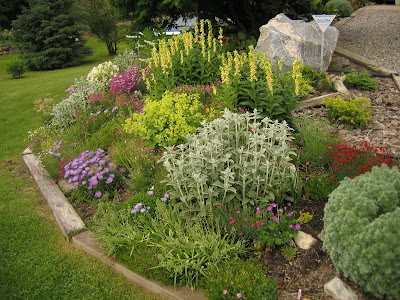Tradescantia "Little Doll", a new plant purchased for me last year by resident-lawnmower-man.

This gorgeous annual is the 24-inch tall Lavatera "Silver Cup".

I planted a few Lavatera in my yard and one over at my sister-in-law's place. She has been so gracious in letting me have full access to her yard's dirt, a very positive personal characteristic. I plan to keep on taking advantage of this trait by planting even more exciting new annuals over there next year. In contrast, my mother likes to stick with the "tried and true". Geraniums or bust, her motto could be (though this year I may have convinced her to try a few new ones). I'm addicted to new plants and this will keep my nose in the seed catalogs all winter.
Lilies are in full bloom in the perennial beds:

Look at this, my Okanagan relatives. I grew cherries! We planted these three years ago and this is their first fruiting year. They are tart cherries called "SK Carmine Jewel". They apparently have just as much sugar in them as sweet cherries, but more citric acid, which makes them a bit tart compared to the sweet ones. I bought the young trees from DNA gardens in Alberta, which has a really great selection of novelty fruiting trees and shrubs. The tree itself is darling, a perfect little ball of dark glossy leaves on a short single trunk.

A group of lilies, including the hideous orange one that mysteriously trespassed on my garden this year. I have tied a string around its stem to identify the offender, which must be dug out and given away.


















































